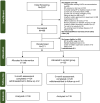Effects of Sedentary Behavior Reduction on Blood Pressure in Desk Workers: Results From the RESET-BP Randomized Clinical Trial
- PMID: 39166323
- PMCID: PMC11512617
- DOI: 10.1161/CIRCULATIONAHA.123.068564
Effects of Sedentary Behavior Reduction on Blood Pressure in Desk Workers: Results From the RESET-BP Randomized Clinical Trial
Abstract
Background: Sedentary behavior (SB) is observationally associated with cardiovascular disease risk. However, randomized clinical trials testing causation are limited. We hypothesized that reducing SB would decrease blood pressure (BP) and pulse wave velocity (PWV) in sedentary adults.
Methods: This parallel-arm, 3-month randomized clinical trial recruited desk workers, age 18 to 65 years, with systolic BP 120 to 159 or diastolic BP (DBP) 80 to 99 mm Hg, off antihypertensive medications, and reporting <150 min/wk of moderate to vigorous intensity physical activity. Participants were randomized to a SB reduction intervention or a no-contact control group. The intervention sought to replace 2 to 4 h/d of SB with standing and stepping through coaching, a wrist-worn activity prompter, and a sit-stand desk. SB and physical activity were measured with a thigh-worn accelerometer and quantified during all waking hours and separately during work and nonwork times. Clinic-based resting systolic BP (primary outcome) and DBP, 24-hour ambulatory BP, and PWV were assessed by blinded technicians at baseline and 3 months.
Results: Participants (n=271) had a mean age of 45 years and systolic BP/DBP 129/83 mm Hg. Compared with controls, intervention participants reduced SB (-1.15±0.17 h/d), increased standing (0.94±0.14 h/d), and increased stepping (5.4±2.4 min/d; all P<0.05). SB and activity changes mainly occurred during work time and were below the goal. The intervention did not reduce BP or PWV in the intervention group compared with controls. Between-group differences in resting systolic BP and DBP changes were -0.22±0.90 (P=0.808) and 0.13±0.61 mm Hg (P=0.827), respectively. The findings were similarly null for ambulatory BP and PWV. Decreases in work-time SB were associated with favorable reductions in resting DBP (r=0.15, P=0.017). Contrary to our hypotheses, reductions in work-time SB (r=-0.19, P=0.006) and increases in work-time standing (r=0.17, P=0.011) were associated with unfavorable increases in carotid-femoral PWV. As expected, increases in nonwork-time standing were favorably associated with carotid-femoral PWV (r=-0.14, P=0.038).
Conclusions: A 3-month intervention that decreased SB and increased standing by ≈1 hour during the work day was not effective for reducing BP. Future directions include examining effects of interventions reducing SB through activity other than work-time standing and clarifying association between standing and PWV in opposite directions for work and nonwork time.
Registration: URL: https://www.clinicaltrials.gov; Unique identifier: NCT03307343.
Keywords: behavior; blood pressure; randomized controlled trial; vascular stiffness; work.
Conflict of interest statement
Dr Jakicic reports participation on a Scientific Advisory Board for Wondr Health, Inc; ownership of Healthy Lifestyles Consulting, LLC; and a role as principal investigator of the clinical site for a research study awarded to the University of Kansas Medical Center by Epitomee Medical, Inc. The other authors report no relevant conflicts of interest.
Figures
References
-
- Whelton PK, Carey RM, Aronow WS, Casey DE, Collins KJ, Dennison Himmelfarb C, DePalma SM, Gidding S, Jamerson KA, Jones DW, et al. 2017 ACC/AHA/AAPA/ABC/ACPM/AGS/APhA/ASH/ASPC/NMA/PCNA guideline for the prevention, detection, evaluation, and management of high blood pressure in adults: a report of the American College of Cardiology/American Heart Association task force on clinical practice guidelines. Hypertension. 2018;71:e13–e115. doi: 10.1161/HYP.0000000000000065 - PubMed
-
- Tremblay MS, Aubert S, Barnes JD, Saunders TJ, Carson V, Latimer-Cheung AE, Chastin SFM, Altenburg TM, Chinapaw MJM; SBRN Terminology Consensus Project Participants. Sedentary Behavior Research Network (SBRN)–terminology consensus project process and outcome. Int J Behav Nutr Phys Act. 2017;14:75. doi: 10.1186/s12966-017-0525-8 - PMC - PubMed
-
- Katzmarzyk PT, Powell KE, Jakicic JM, Troiano RP, Piercy K, Tennant B; 2018 Physical Activity Guidelines Advisory Committee. Sedentary behavior and health: update from the 2018 physical activity guidelines advisory committee. Med Sci Sports Exerc. 2019;51:1227–1241. doi: 10.1249/MSS.0000000000001935 - PMC - PubMed
Publication types
MeSH terms
Associated data
Grants and funding
LinkOut - more resources
Full Text Sources
Medical
Research Materials


